Who Is Daniel Farke?
After more than a year at Leeds United, Daniel Farke has already built a recognisable team in the EFL Championship.
He knew the tournament well after five years at Norwich City, where he was promoted to the Premier League and relegated twice.
Ten years ago, he worked alongside Thomas Tuchel at Borussia Dortmund Reserves, where some elements of Daniel Farke’s coaching style were derived.
After leaving Norwich three years ago, he passed through Krasnodar and Borussia Mönchengladbach, but none of these were as recognisable teams as his Norwich side in England.
His philosophy seems solid, and his key players have shown an exciting potential to compete for promotion this season.
In this head coach analysis & tactical analysis, we will provide a complete view of Daniel Farke’s tactics this season at Leeds United.
Daniel Farke’s Style Of Play
“It’s about being dominant. I want our players to be protagonists on the pitch. I like to have the ball—if I could choose, I would have the ball for 90 minutes.” Farke told The Independent in 2017.
With this, we can create a picture of Daniel Farke’s style of play.
Daniel Farke’s playing model is prominently positional football — maybe the most representative positional proposal in the Championship right now.
Daniel Farke’s Tactics In Possession
Under Daniel Farke’s tactics, Leeds United are daring in possession.
They always want the ball and as much time as possible.
Leeds have the second-highest percentage of possession in the Championship—let’s discuss their structure and how they do this.
In general, their shape is a 4-2-3-1 that resembles Daniel Farke’s formation at Norwich.

Where The Play Starts In Possession: Build-Up Details
The most crucial phase with the ball for Daniel Farke’s Leeds is the beginning of the possession.
In that sense, their centre-backs are the team’s soul: Pascal Struijk and Joe Rodon, two old acquaintances from the Premier League.
Centre-backs position themselves high and wide in the build-up, looking for progress by exploiting their clean passing range.
They feel great in this style of play, defending as little as possible, being left-footed and right-footed in natural positions, and playing wide to get a better view of the pitch.
In these first matches of the Championship, they seem like the perfect couple.
Pascal Struijk & Joe Rodon Progressive Passes Map

From there, Leeds builds its structure, and other players move forward, considering that the ball is safe in Rodon or Struijk’s feet and that they will progress if they have the chance.
They are capable of playing around or through the opposition accurately.
Both centre-backs’ abilities in possession allow progression to the next phase of possession.
Considering the wide position of the centre-backs, the role of the wide defenders in the team is also crucial.
Junior Firpo and Jayden Bogle, both natural wingbacks, are always high and placed one height above the centrebacks.
Since the beginning of the play, they have been responsible for providing the maximum structural width, positioning themselves higher while the possession is advancing and the opponent is sinking.

So, Leeds have a lot of space in the first line, but their wing-backs are not there, and their centre-backs are positioned wide.
Depending on the rival/moment, Leeds can also build up with one of their midfielders—Rothwell, Tanaka, Ampadu, or Gruev—dropping in and helping to progress and control the possession with vision and clarity.
They apply this adjustment mostly when the rival is strong in the mid-block, and they can progress without stumbling close to their box.
In this way, they can pin the position of the opposing midfielders pressing Leeds’ double-pivot.


Central Overloads
This 4-2-3-1 tends to become a 4-3-3 with different heights and channels between the double-pivot and the attacking midfielder (Aaronson) and a 4-4-2 in the defensive phase, with the ‘10’ moving into the forward line.
That configuration sounds familiar.
It has been one of the most commonly-used ones in each phase in recent seasons, with different approaches from each team.
Without going very far, we have spoken about how Régis Le Bris’ Sunderland uses the same shape to create wide overloads during possession.
In this case, Farke uses it to create central overloads.

Leeds’ wingers move into inner channels and they accumulate four players there while the wing-backs advance.
With the ball in the centre-back’s feet and the double pivot deeper in rest defence, if possession is lost, Leeds has two ways to progress in positional attacks.
The first one is playing around from the backline.
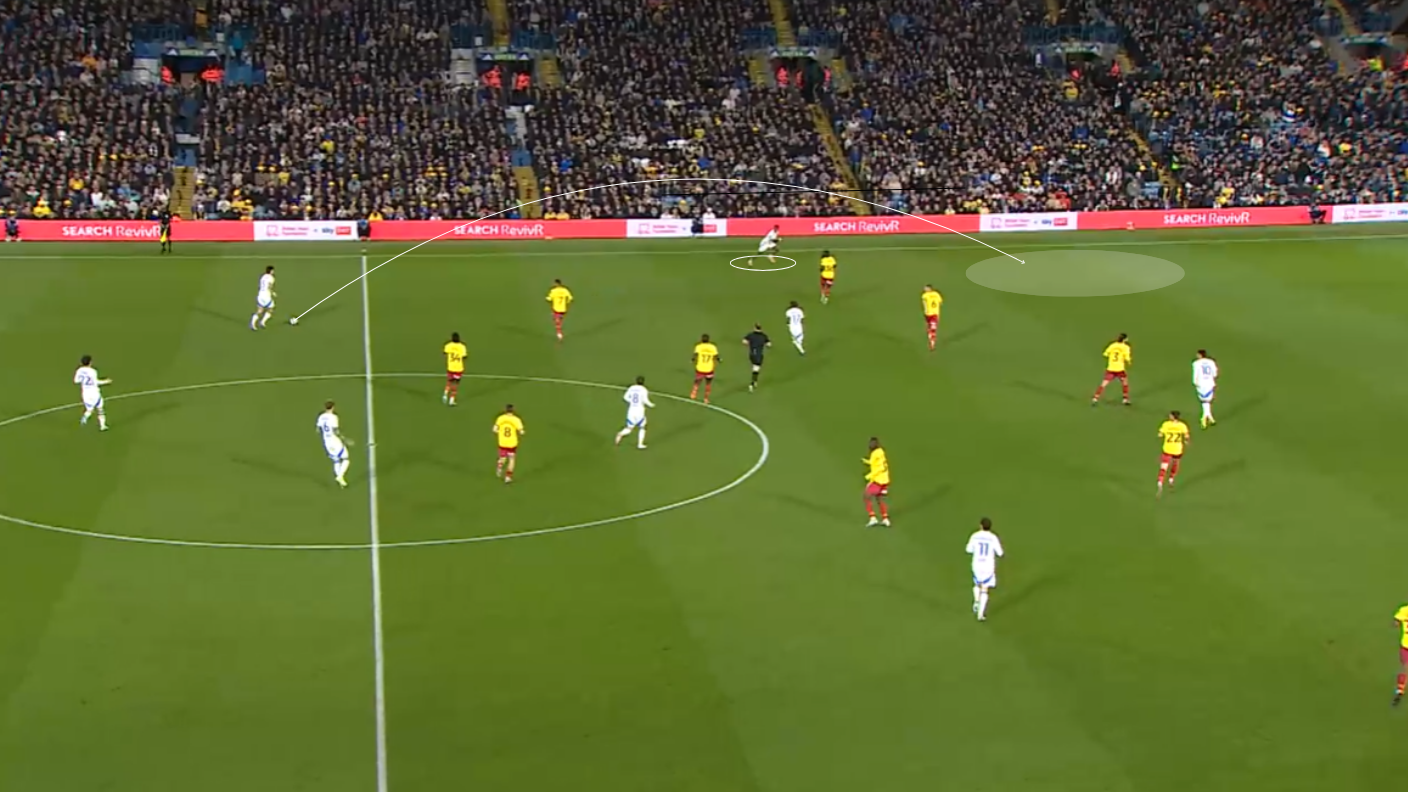
Rodon & Struijk’s technique of launching is fantastic to find Junior or Bogle running in behind and send passes to them.
Even if they are very pressed, Junior and Bogle have excellent carrying techniques, which means that they can progress from deeper positions as wingbacks.
Junior Firpo & Jayden Bogle Ball Progression Map
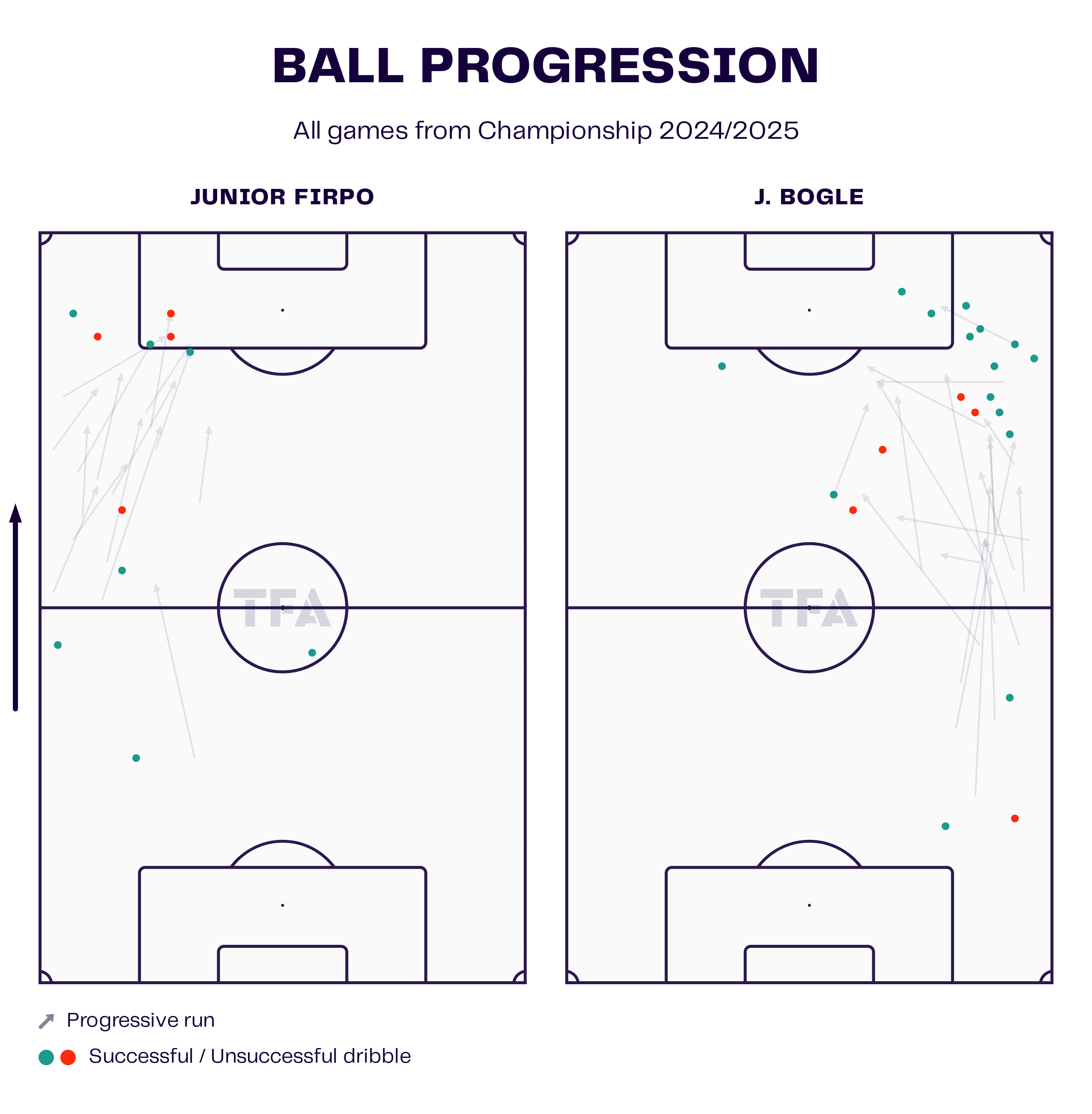
They tend to arrive aggressively into finishing zones after completing underlaps or attacking the weak side.
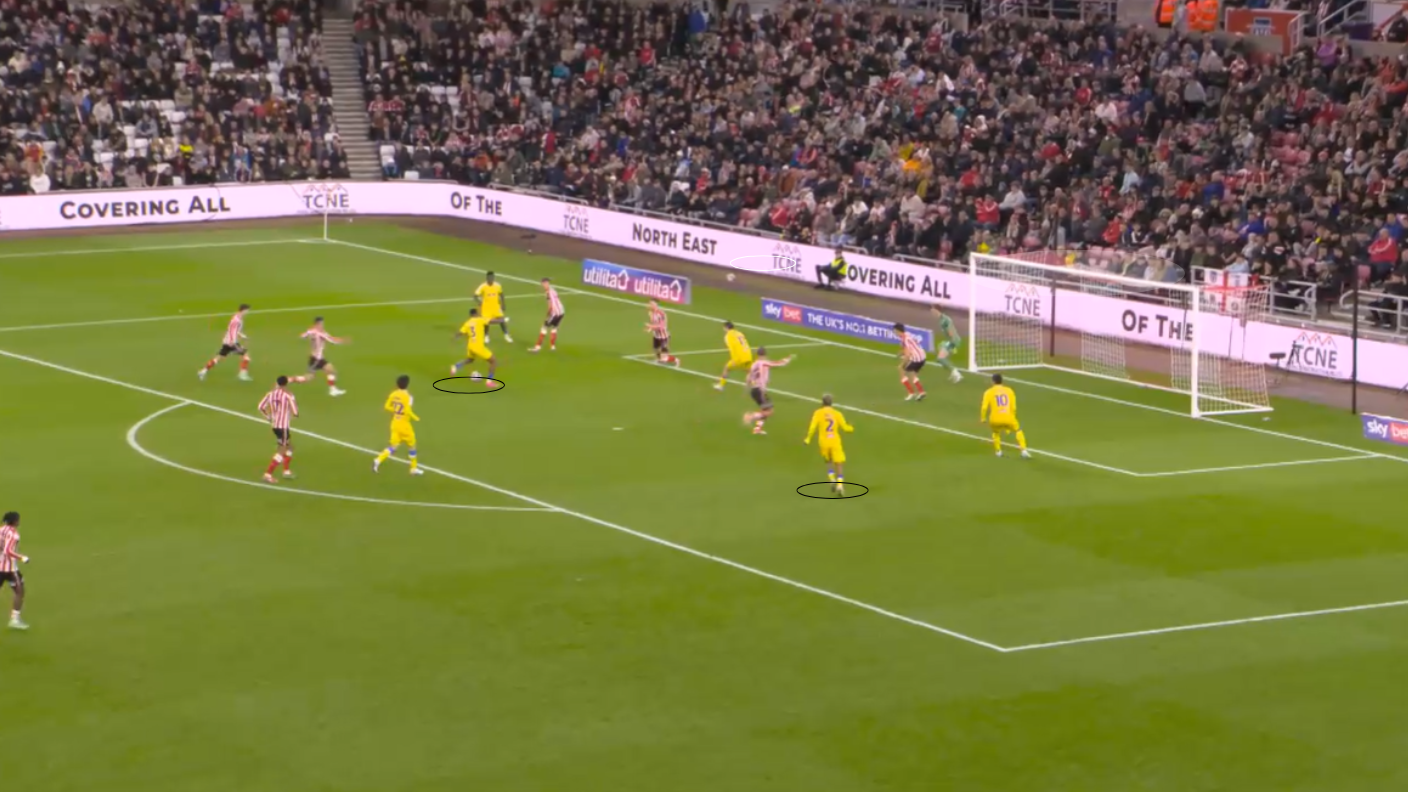
But what happens when Leeds play through in the build-up?
Well, Daniel Farke has decided to position his wingers there to create some inner dribble and imbalance in the central channels.
If Struijk (mainly) and Rodon’s capacity to complete complex passes inside is understood, Leeds’ dribbling talent can make the difference in advanced and central zones.
This is valuable; if the ball is inside and a team can progress from there, the finishing is closer than in wide positions.
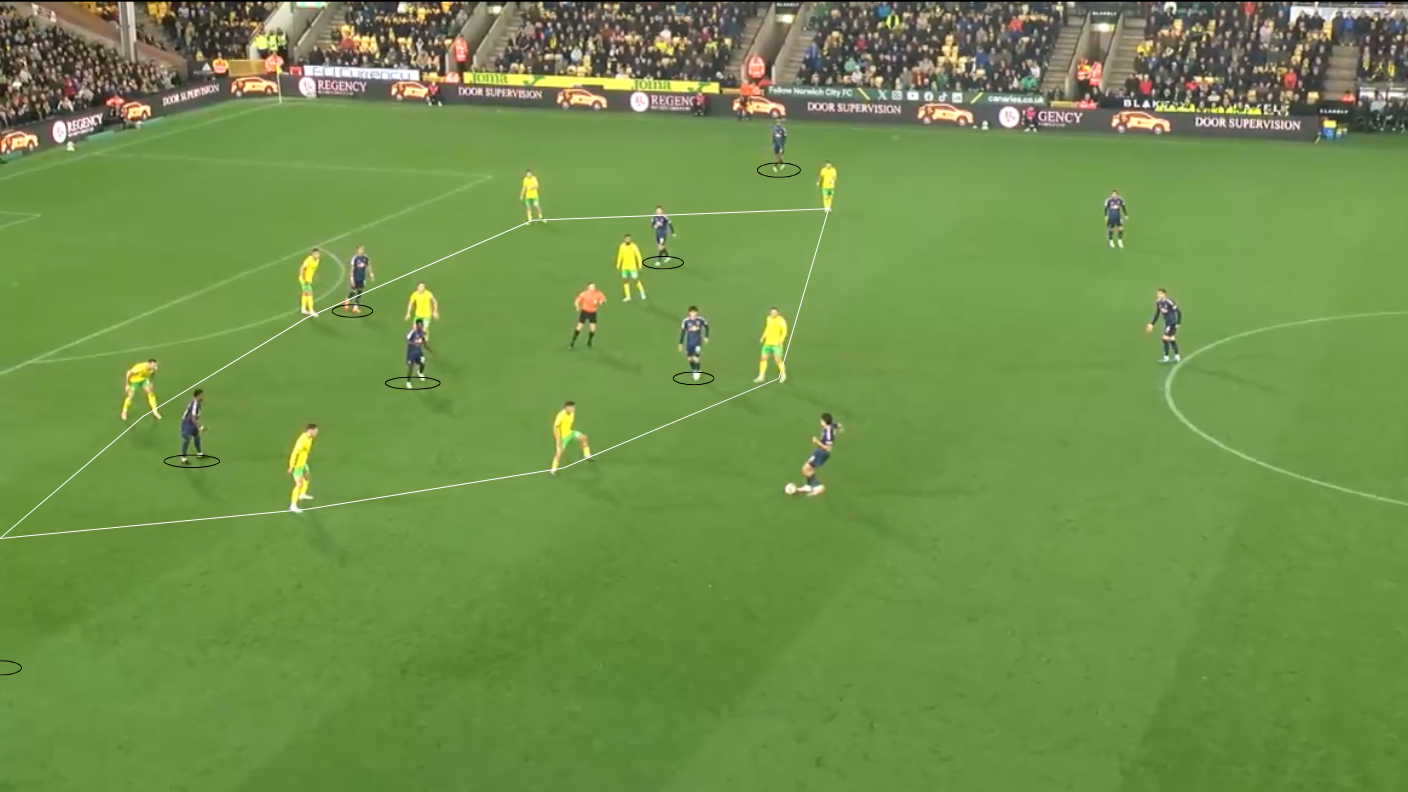
There, Wilfred Gnonto has been the most critical winger starting wide and going inside.
The 20-year-old is small in height and can escape from congested areas and progress quickly, thanks to his low centre of gravity and fast change of pace/direction.
Wilfred Gnonto Ball Progression Map
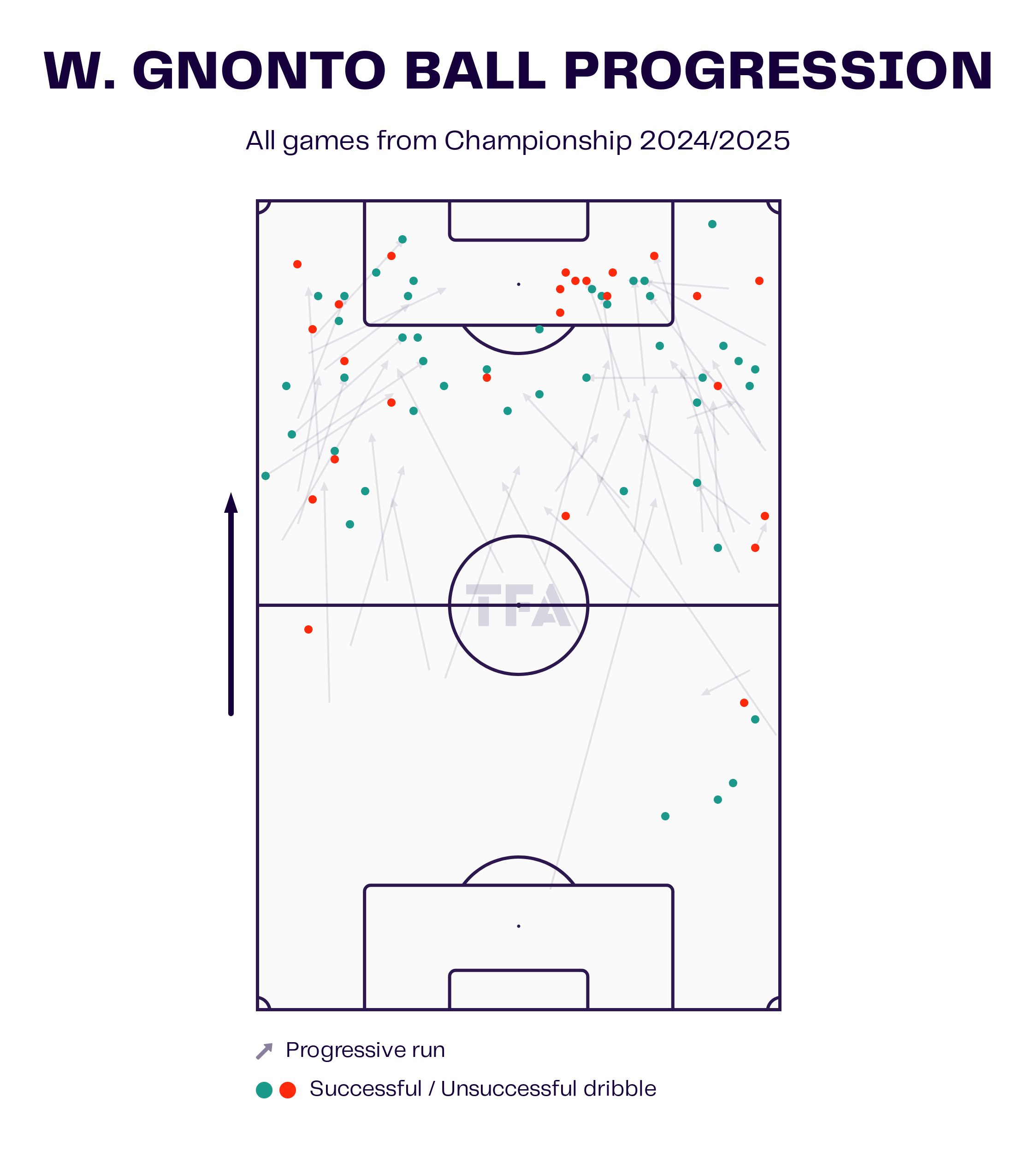
With other dribblers and pure wingers like Manor Solomon, Largie Ramazani and Daniel James, this Leeds will boost their performances by using them in the central lanes and trying to shake in tight spaces.
Out-Of-Possession Behaviour
Daniel Farke’s philosophy in the Championship has always been daring, as we told you before.
But this season at Leeds, it is even more-so than any other.
His defensive line is clearly higher than before, and Leeds avoid defending in their box as much as possible.
With the weaknesses that their wing-backs have at the time to defend and their centre-backs in agility (Struijk) and strength (Rodon) terms, defending high is their best way.
So, this Leeds is not very similar to the Championship’s Norwich while defending.
Norwich had many resources in transition and could attack quickly after recovering deeper.
Leeds are better at recovering the ball faster; they need the ball.
And they are more dangerous in positional attacks than in any other phase.
Daniel Farke Defensive Territory Map
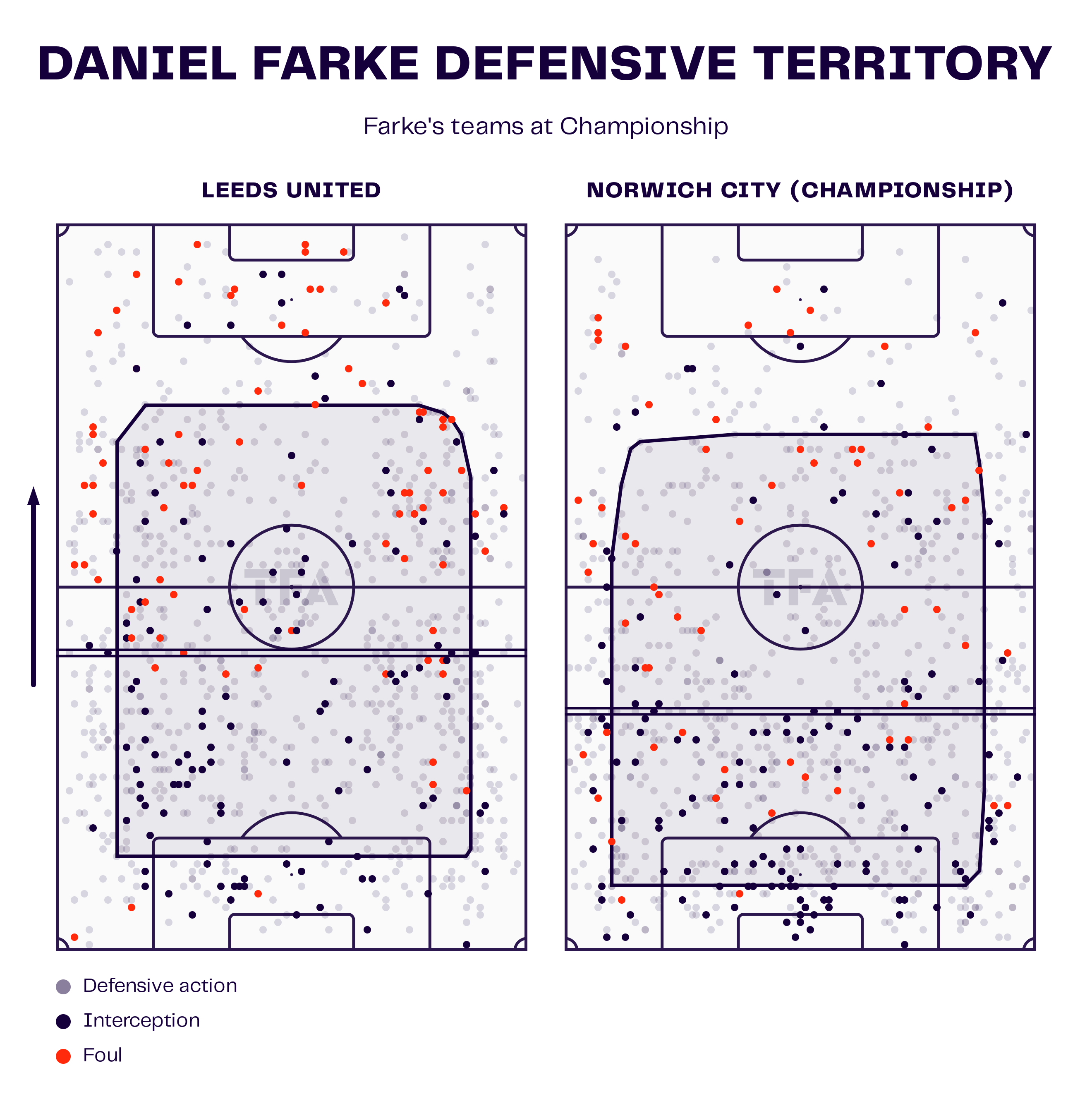
Where The Play Starts Off Possession: Pressing After Loss
As it happens in possession, Leeds’ most valuable aspect without the ball is the beginning.
Once they lose the ball, there is a designated and aggressive man-oriented press.
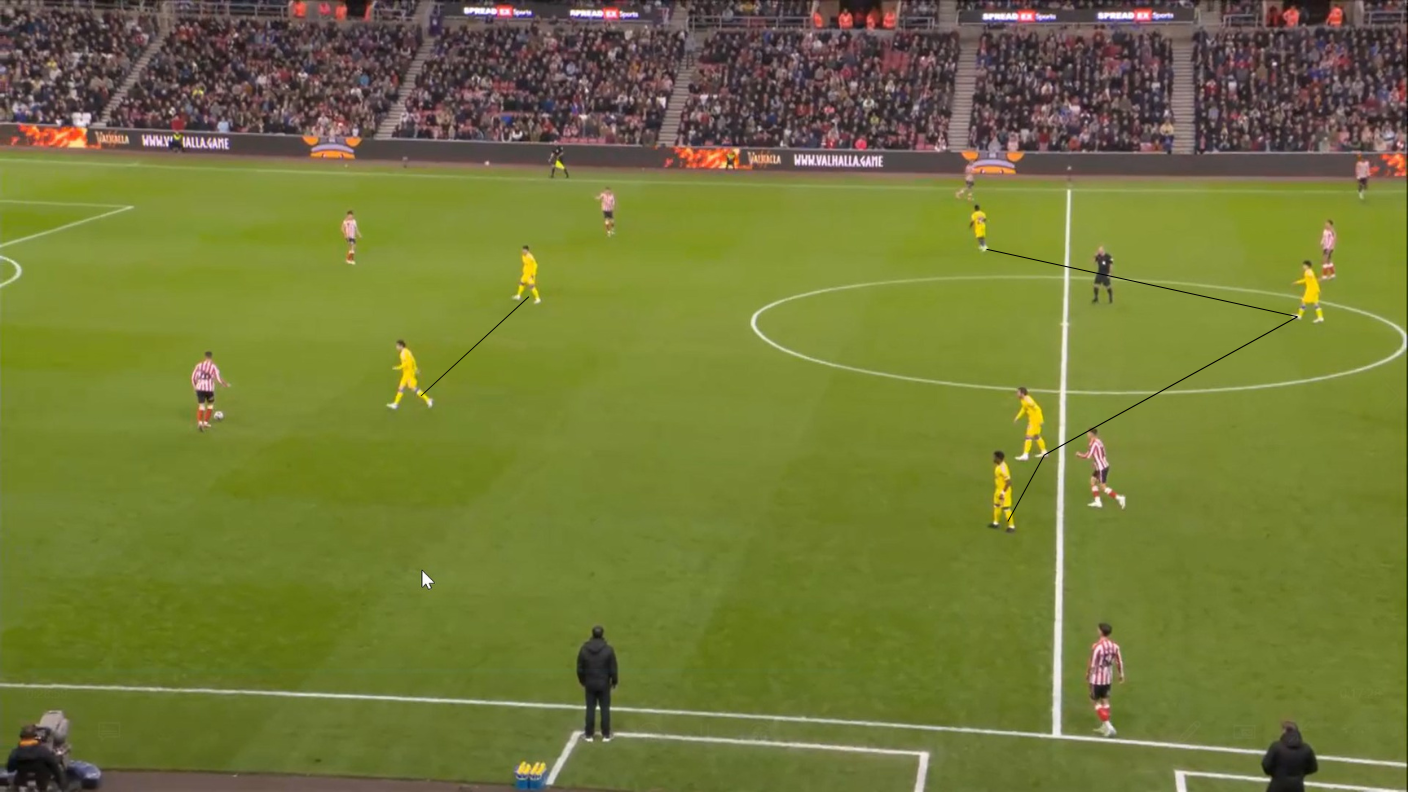
In inner channels, they jump aggressively into central man-to-man marking or wait and reorganise their structure to close channels while the rival progresses.
But when the rival plays on the flanks, they cut the pitch in half with the wing-back pressing higher, using the touchline as one more defender and forgetting the weak side because the player will not be able to make a switch with the oriented press.
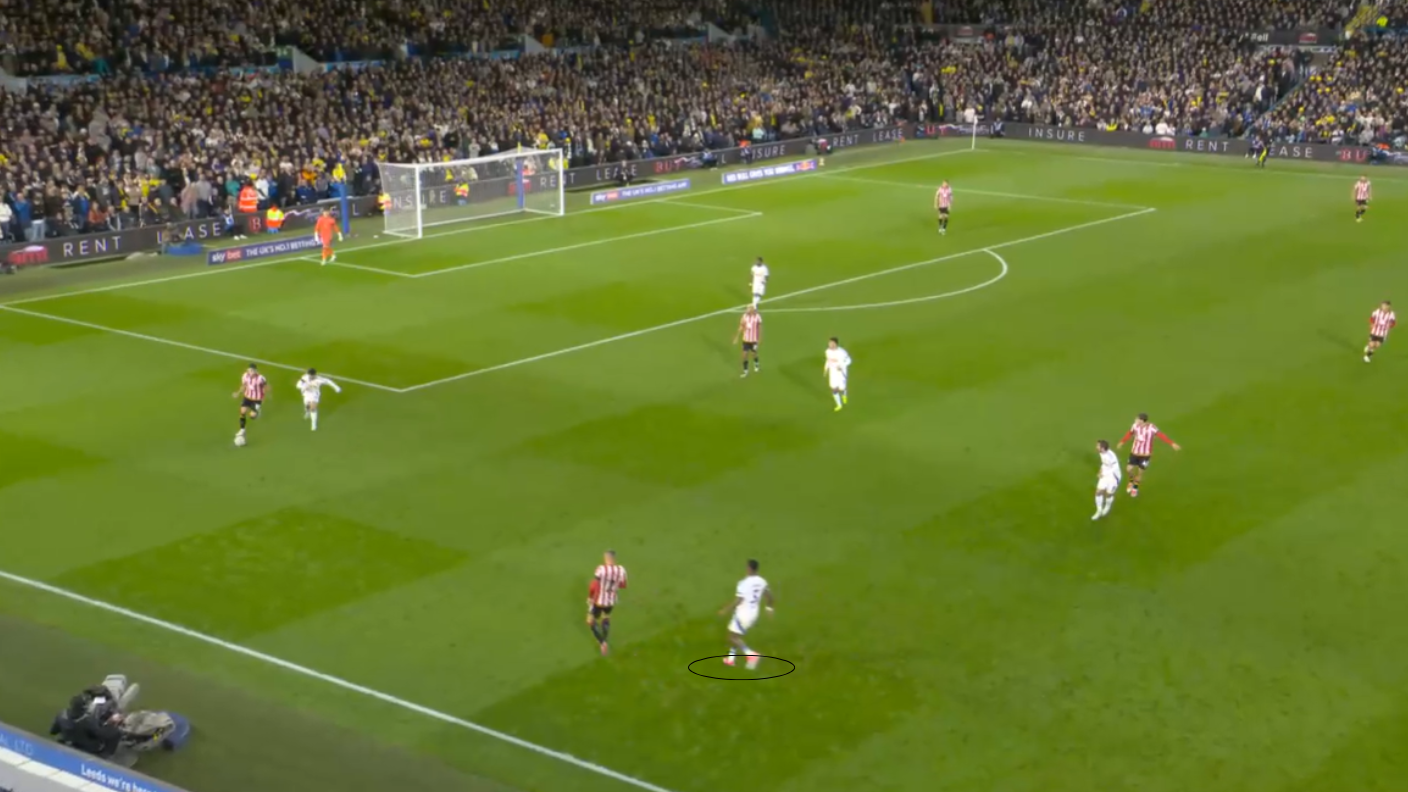
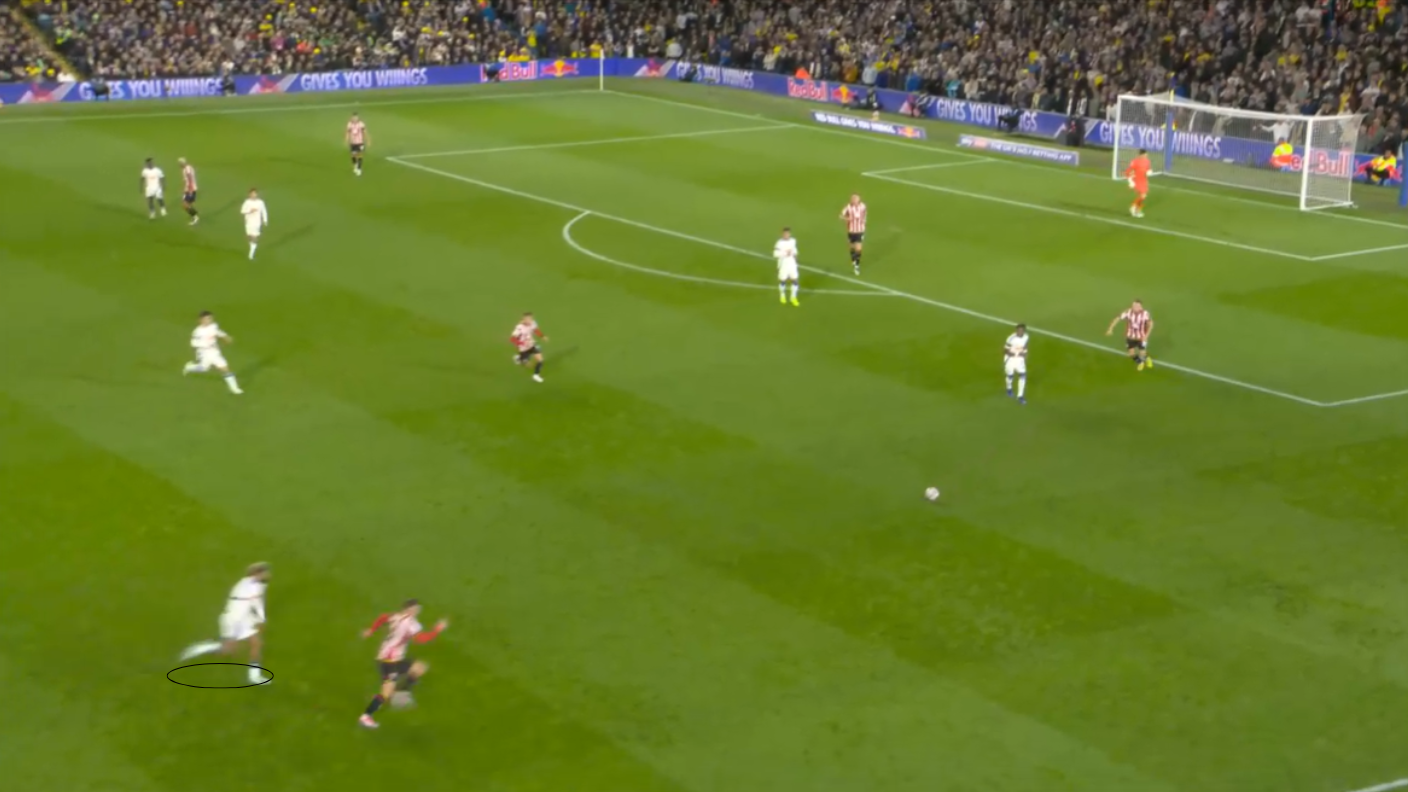
In this phase, more than the structure — which is very important — Farke has many intense players who have stamina and are intelligent while pressing.
After playing at the Champions League level with Union Berlin for one year, Brenden Aaronson returned from his loan to demonstrate his value.
The 24-year-old was already known as a high-press specialist because of his intensity after losing the ball, and now he is a fantastic resource for Leeds.
In addition, Leeds had made the second-highest number of high regains in the Championship at the time of writing, only below Luton Town.
However, the pressing work of this team is impressive.
Leeds United High Regains Map
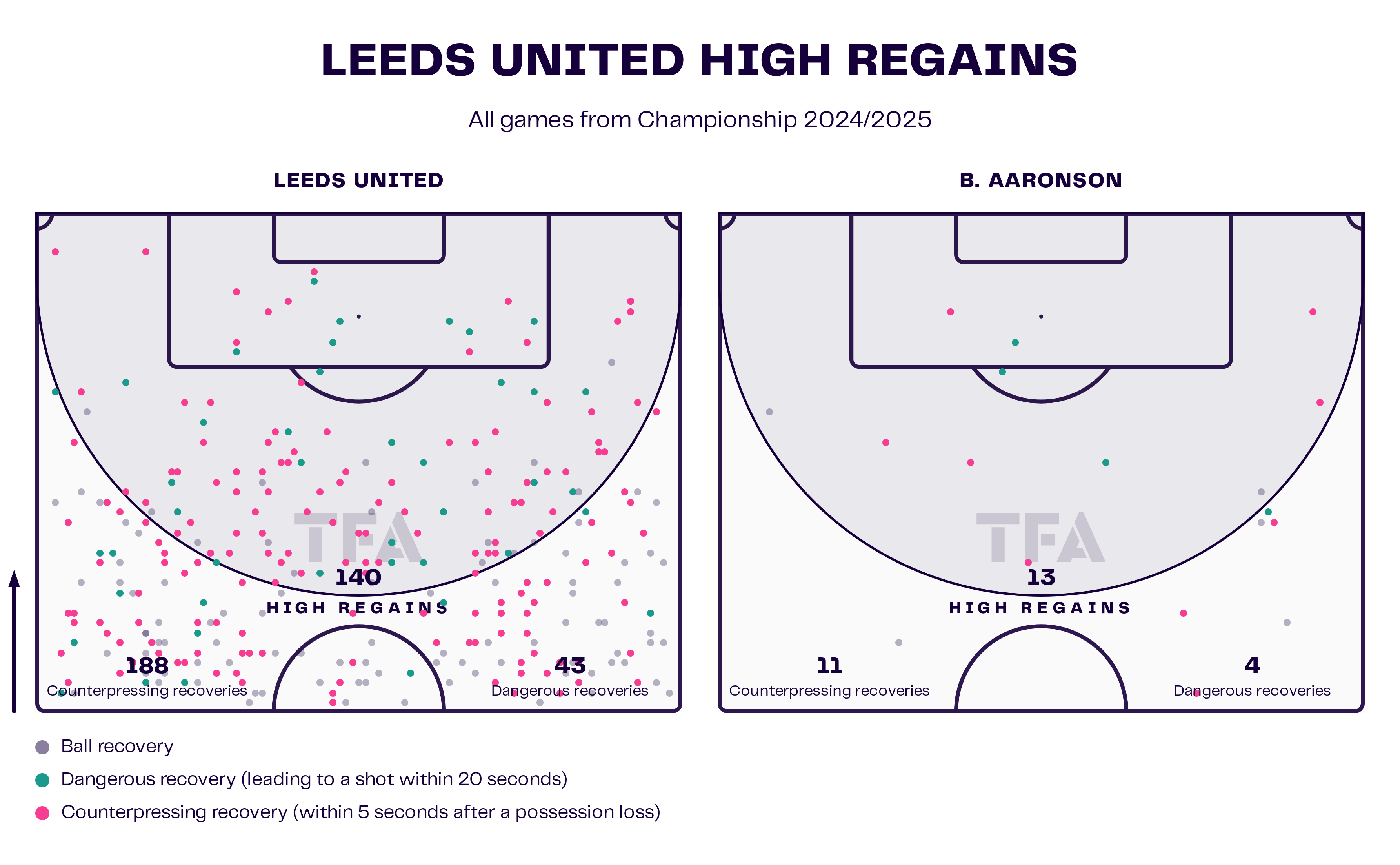
Aaronson offers an impressive volume of counter-pressing so that Leeds can build a solid system around him on that topic.
Gnonto and Ramazani should grow, but they have experienced a considerable volume of committed pressing in recent weeks.
Conclusion
Daniel Farke wishes once again to bring his ideas and playing model to the Championship.
Their last transfer window was good, but if they are going to be promoted, they have to improve the level of some positions to shine and keep reinforcing ideas and the main structure.
We hope that you liked Daniel Farke’s tactics at Leeds United as we made a complete, in-depth analysis.
Still, Ethan Ampadu has to recover after an injury.
He would be the best defensive midfielder on this team because he is capable of anticipating and completing many defensive actions, so there could yet be significant improvement.






Comments